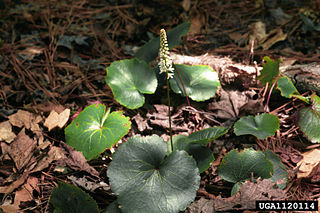
Galax, the wandplant, wandflower, or beetleweed, is a genus in the flowering plant family Diapensiaceae, containing a single species, Galax urceolata. It is native to the southeastern United States from Massachusetts and New York south to northern Alabama, growing mainly in the Appalachian Mountains at altitudes of up to 1,500 m, where it grows in shaded places in forests. Galax urceolata can occur at multiple ploidy levels, an individual may be a diploid (2x), triploid (3x), or autotetraploid (4x) (autopolyploid). The cytotypes are neither morphologically nor geographically distinct, though there are slight climatic differences between the diploid and autotetraploid types. Outcrossing is likely to occur among cytotypes as well.

This is a list of topics in evolutionary biology.

Peter Hamilton Raven is an American botanist and environmentalist, notable as the longtime director, now President Emeritus, of the Missouri Botanical Garden.

George Ledyard Stebbins Jr. was an American botanist and geneticist who is widely regarded as one of the leading evolutionary biologists of the 20th century. Stebbins received his Ph.D. in botany from Harvard University in 1931. He went on to the University of California, Berkeley, where his work with E. B. Babcock on the genetic evolution of plant species, and his association with a group of evolutionary biologists known as the Bay Area Biosystematists, led him to develop a comprehensive synthesis of plant evolution incorporating genetics.

Variation and Evolution in Plants is a book written by G. Ledyard Stebbins, published in 1950. It is one of the key publications embodying the modern synthesis of evolution and genetics, as the first comprehensive publication to discuss the relationship between genetics and natural selection in plants. The book has been described by plant systematist Peter H. Raven as "the most important book on plant evolution of the 20th century" and it remains one of the most cited texts on plant evolution.
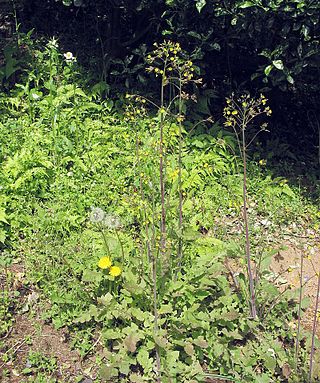
Youngia is a genus of Asian plants in the tribe Cichorieae within the family Asteraceae. There are several weedy species in the genus as well as the endangered Youngia nilgiriensis from Sispara in southern India, and Youngia japonica, which is also known as Japanese hawkweed.
Edgar Shannon Anderson was an American botanist. He introduced the term introgressive hybridization and his 1949 book of that title was an original and important contribution to botanical genetics. His work on the transfer and origin of adaptations through natural hybridization continues to be relevant.
A polyploid complex, also called a diploid-polyploid complex, is a group of interrelated and interbreeding species that also have differing levels of ploidy that can allow interbreeding.
The following outline is provided as an overview of and topical guide to botany:

Galium angustifolium is a species of flowering plant in the coffee family known by the common name narrowleaf bedstraw. It is native to California and Baja California, where it is most commonly found at low elevations in the mountains.
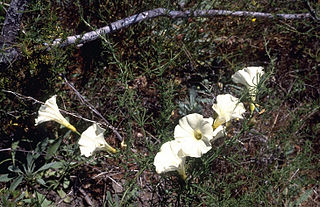
Calystegia stebbinsii is a rare species of morning glory known by the common name Stebbins' false bindweed. It is endemic to the Sierra Nevada foothills of California, where it is known from only two spots in El Dorado and Nevada Counties. It grows in unique habitat in chaparral on gabbro soils. It is a federally listed endangered species.
Nils Heribert-Nilsson was a Swedish botanist and geneticist.
Galium johnstonii is a plant species in the Rubiaceae. It is endemic to California, United States, known from four counties: San Bernardino, Los Angeles, Riverside and San Diego. It is dioecious, with male and female flowers on separate plants.
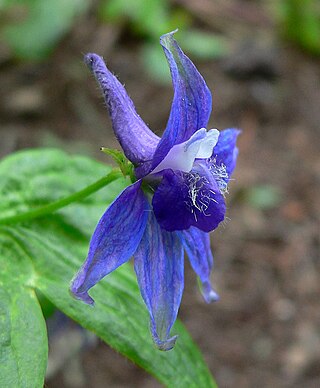
The CNPS Inventory of Rare and Endangered Plants of California is a botanical online database providing information on rare, threatened, and endangered California native plants. It is sponsored by the California Native Plant Society (CNPS).
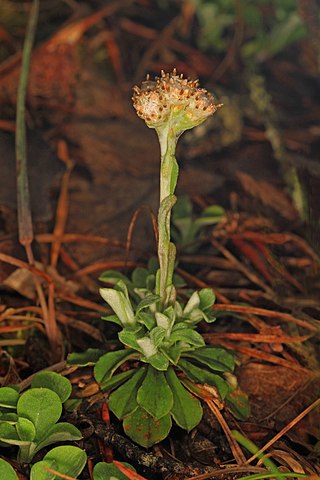
Antennaria virginica is a North American species of flowering plants in the family Asteraceae known by the common names shalebarren pussytoes. It grows on Devonian shale in the eastern United States. It is found in central Appalachian Mountains of Pennsylvania, Maryland, West Virginia, and Virginia, with a few populations in eastern Ohio.
The Stebbins system is an angiosperm plants classification drawn up by the American botanist G. Ledyard Stebbins (1906–2000). The system was published in the book Flowering plants: evolution above the species level (1974), and was followed by Vernon Heywood in his Flowering plants of the world (1978).

Herbert George Baker was a British-American botanist and evolutionary ecologist who was an authority on pollination biology and breeding systems of angiosperms. He described what became known as "Baker's rule," a theoretical proposal underpinning an empirical observation that the ability to self-fertilize improves colonization ability among plants by increasing the probability of successful establishment after long-distance dispersal. He collaborated with his wife, Irene Baker, studying the content and function of nectar, and undertaking research and publishing papers on its evolutionary and taxonomic significance.
Soroseris glomerata is a species of thick stem flowering plant in the family Asteraceae, a type of lettuce with small leaves of China, where it is called 绢毛菊.
Invasion genetics is the area of study within biology that examines evolutionary processes in the context of biological invasions. Invasion genetics considers how genetic and demographic factors affect the success of a species introduced outside of its native range, and how the mechanisms of evolution, such as natural selection, mutation, and genetic drift, operate in these populations. Researchers exploring these questions draw upon theory and approaches from a range of biological disciplines, including population genetics, evolutionary ecology, population biology, and phylogeography.











